In this article:
The cold temperature and dry wind of the winter weather draw moisture away from your skin. As a result, your skin develops dry, flaky, and cracked patches, leaving you with a dull complexion. The low humidity levels also lead to poorer skin hydration and red, itchy skin.

To minimize the skin damage caused by the winter on your skin, you need a consistent skin care routine, as well as a healthy diet. Various foods can help boost radiance and glow, which are indicators of healthy skin.
Below are some nutritious foods that help keep your skin healthy and glowing during the harsh winter season.
1. Avocados
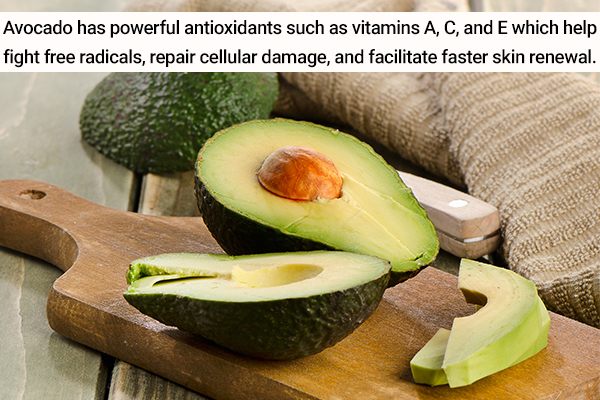
Avocados are loaded with several nutrients that improve your skin quality in different ways. They contain powerful antioxidants such as vitamins A, C, and E, which help fight free radicals, repair cellular damage, and facilitate faster skin renewal.
Avocados are renowned for their rich content of healthy monounsaturated fats, (1) which provide hydration and volume to the skin, making it soft, supple, and tight. Plus, this fruit contains folic acid, magnesium, and potassium that help improve your skin tone. (2)
How to use:
- Scoop out the flesh of half of an avocado into a bowl, drizzle some lemon juice or your favorite seasoning over it, and enjoy it raw.
- Toss some avocado slices in your salads.
Make a moisturizing avocado face mask:
- Slice avocado in half.
- Scoop out the flesh and mash it thoroughly so that there are no lumps.
- Mix 1 tablespoon each of honey and yogurt in the paste.
- Apply a thin layer of the paste to your face.
- Let it dry completely before rinsing it off with lukewarm water.
2. Carrots
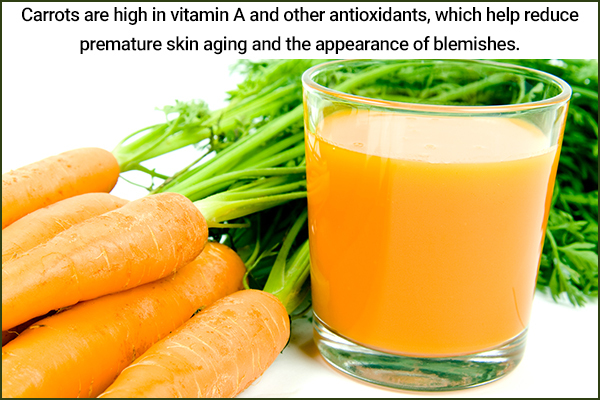
Carrots are high in vitamin A and other antioxidants, (3) which help reduce premature skin aging and the appearance of blemishes. Carrots also help treat discoloration and uneven skin tone by providing a youthful, radiant skin complexion.
Moreover, carrots contain the carotenoids beta-carotene and lycopene, (4) which help protect your skin from UV damage and improve its overall skin tone. The high potassium content in carrots helps moisturize your skin, giving it a nourished and hydrated glow.
How to use:
Drink 1 glass of fresh carrot juice every day as it can boost your immunity and enhance skin glow.
Make a carrot face mask:
- Mix 3–4 tablespoons of pureed carrots, 2 tablespoons each of raw honey and yogurt, and a few drops of coconut oil.
- Apply a thick and even layer of this DIY paste to your face.
- Let the paste sit on your skin for 10–15 minutes.
- Wash your face with lukewarm water.
3. Broccoli
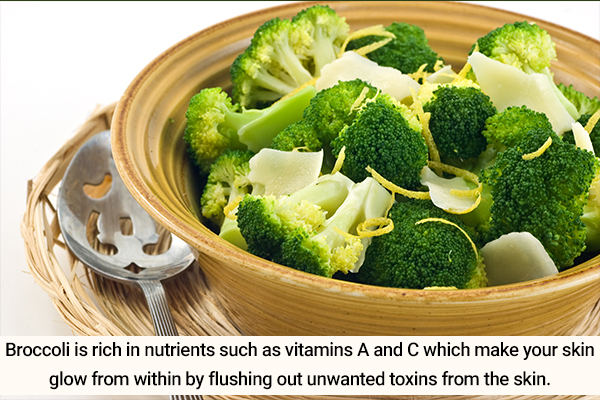
Broccoli is rich in skin-beneficial nutrients such as vitamins A and C, (5) which make your skin glow from within by flushing out unwanted toxins from the skin.
Vitamin A protects the skin cell membranes and prevents UV damage, (6) whereas vitamin C encourages collagen production (6) to make new skin cells.
Additionally, the B vitamins found in broccoli help enhance the overall health of your skin cells while also providing intensive skin hydration to heal dry, flaky patches.
How to use:
- Include a portion of broccoli in your daily meals to make your skin glow from the inside out.
- You can boil the broccoli for a few minutes (al dente) and add it to different dishes like stir-fries, salads, and soups.
- You can also season it with your favorite dressing and serve it as a side dish.
4. Almonds

Almonds are high in antioxidants, which benefit your skin (7) by promoting a nourished, glowing skin appearance. One of these antioxidants is vitamin E, which not only moisturizes your skin but also shields it from the sun’s harmful UV rays. (8)
Almonds are also known to have antiaging properties that aid in the reduction of wrinkles, fine lines, and other signs of premature skin aging. (7)
How to use:
Use almond oil:
- Heat the needed amount of almond oil until lukewarm.
- Massage it all over the dry patches for 20–25 minutes.
Make an almond face scrub:
- Soak 5–6 almonds in water overnight.
- Peel off the skin and grind the almonds into powder form.
- Add 5 tablespoons of raw milk to the powdered almonds to form a paste.
- Gently massage your face with this paste for 5–10 minutes.
- Rinse the paste off using lukewarm water.
5. Spinach
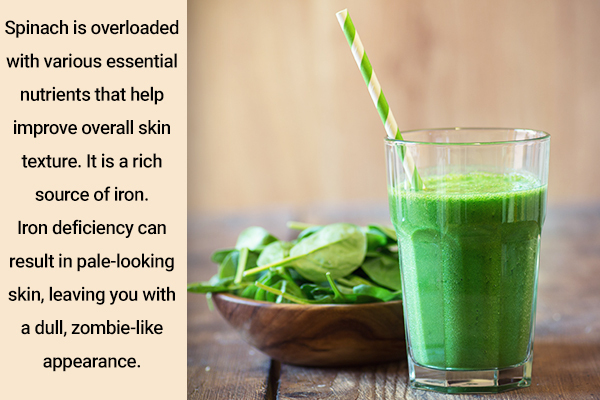
Spinach is overloaded with various essential nutrients that help improve overall skin texture. It is rich in vitamin A, an antioxidant (9) that helps clean the skin inside out by boosting blood flow.
Vitamin C, another antioxidant present in spinach, aids in skin cell renewal, (10) giving you firm, radiant, and even-toned skin.
In addition, spinach is a rich source of iron. (11) Iron deficiency can result in pale-looking skin, (12) leaving you with a dull, zombie-like appearance. Additionally, lutein, which is also found in spinach, protects the skin from sun damage. (13)
How to use:
Include spinach in your soups, salads, and other meals.
Drink skin-detoxifying spinach juice:
- Mix ½ glass of fresh spinach juice with some lemon juice.
- You can also include berries in the juice for improved taste.
- Consume this juice daily to avoid dry, chaffed, and irritated skin.
6. Green tea
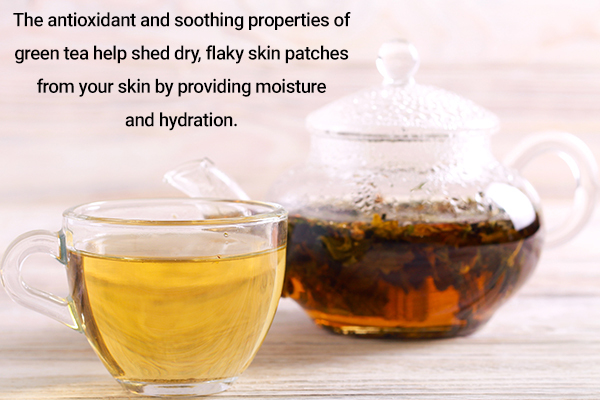
Green tea is high in antioxidants that protect your skin from free radical damage. (14)
The antioxidant and soothing properties of green tea help shed dry, flaky skin patches from your skin by providing moisture and hydration. They also help soothe the redness and irritation caused by the dryness during winter.
Moreover, green tea’s polyphenols can help prevent and minimize the signs of premature aging (15) and the appearance of wrinkles, blemishes, dark spots, and sagging skin.
How to use:
Consume 2–3 cups of green tea every day to achieve a radiant skin complexion.
7. Salmon
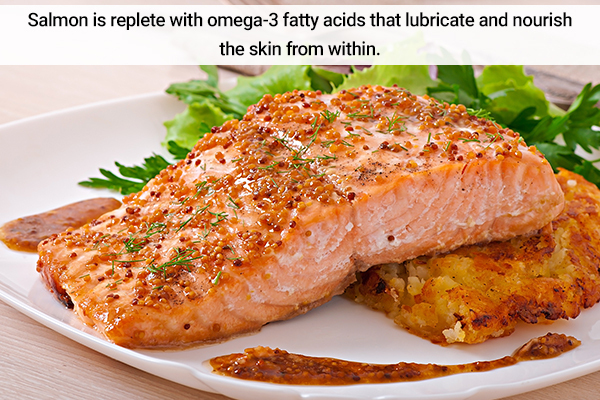
Salmon is replete with omega-3 fatty acids that lubricate and nourish the skin from within. (16) They possess anti-inflammatory properties that help soothe dry, irritated skin.
Salmon also contains selenium, (17) a mineral that helps protect your skin from sun damage. It is rich in zinc that boosts the skin renewal process.
The essential vitamins, antioxidants, and omega-3 fatty acids work together to give you supple, healthy skin.
How to use:
Consume grilled or baked salmon at least twice a week as part of an overall wholesome and nutritious diet.
8. Dark Chocolate
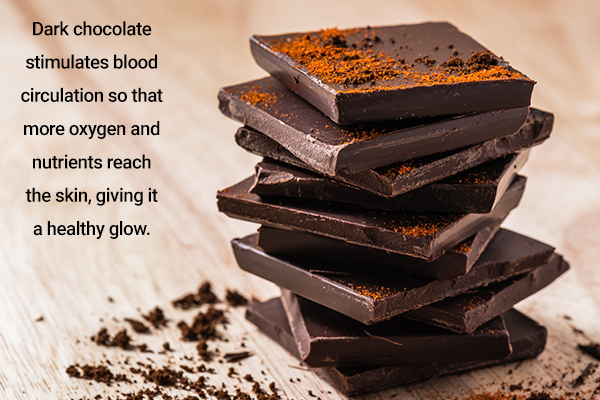
Dark chocolate, especially those that contain at least 70% cocoa, is beneficial to the skin. (18) It is rich in flavanols, (19) which are known to improve skin elasticity, keeping your skin taut and thus averting skin sagging or wrinkle formation.
Free radicals and UV damage destroy skin fibers, causing sagging and premature skin aging, (8) but the antioxidants in dark chocolate ward these free radicals off.
Plus, dark chocolate has intense moisturizing effects on the skin, which is beneficial especially during the harsh winters. It also stimulates blood circulation so that more oxygen and nutrients reach the skin, giving it a healthy glow.
How to use:
Consume 2–3 bars of dark chocolate regularly.
Make a DIY chocolate mask:
- Melt 1 bar of dark chocolate in a double boiler. Stir continuously so that the chocolate doesn’t burn.
- Mix 1 teaspoon each of rice flour and milk cream and a few drops of rosewater in the molten chocolate to form a paste.
- When the paste comes to room temperature, evenly apply a thin layer of it to your face and leave it on for 20 minutes.
- Rinse the paste off using lukewarm water.
9. Oranges
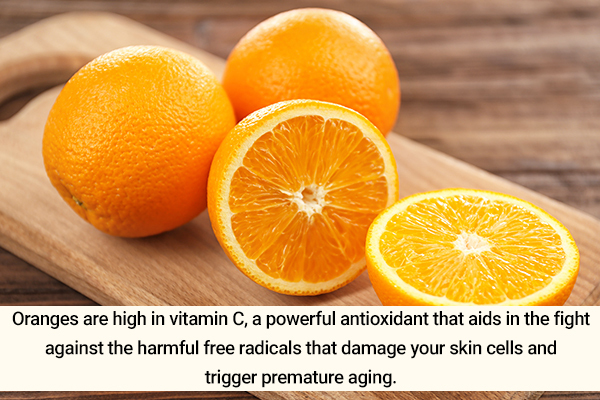
Oranges are high in vitamin C, a powerful antioxidant that aids in the fight against the harmful free radicals (20) that damage your skin cells and trigger premature aging.
Vitamin C also accelerates collagen production, resulting in enhanced skin texture and elasticity and thus providing you with supple, healthy skin.
Oranges contain citric acid, (21) which is highly effective in controlling acne and minimizing pimple appearance. Furthermore, the orange pulp is slightly acidic, which makes for a mild yet effective exfoliant. When used topically, it dissolves or loosens the dead skin cells settled on the surface so that they shed easily.
You can also use powdered orange peel to gently scrub off the dry, dead flakes settled on the surface of your skin to make it bright and smooth.
How to use:
Consume fresh oranges daily to ensure adequate vitamin C intake.
Make a DIY orange face mask:
- Mix 2 tablespoons each of fresh aloe vera gel and orange pulp with a few drops of rosewater to form a paste.
- Evenly apply a thin layer of the DIY face mask to your skin and leave it on for 15 minutes.
- Rinse the mask off with regular water.
- Pat your skin dry and moisturize.
10. Chia Seeds

Chia seeds are skin food as the omega-3 fatty acids in them boost the skin’s collagen levels. (22) Omega-3 fatty acids nourish and moisturize the skin, (23) making it healthy, plump, and radiant.
The abundant vitamin E (24) in chia seeds fights free radicals and stimulates cell growth for faster skin regeneration. Both these properties help minimize the appearance of wrinkles, fine lines, and sagging skin.
How to use:
- Soak 2–3 tablespoons of chia seeds in water or almond milk overnight so that they become soft, and then consume them for breakfast the next morning. Make this a daily ritual.
- Grind raw chia seeds and sprinkle them over your smoothies, oatmeal, avocado toast, muesli, etc.
Make a chia seed face mask:
- Soak 2–3 tablespoons of chia seeds in a glass of water for 20–25 minutes or until they form a gel-like consistency.
- Mix 1 tablespoon each of honey and vitamin E oil in the gel to form a paste.
- Evenly apply the DIY paste to your face and areas of dry skin, and leave it on for 20–25 minutes.
- Rinse the paste off with lukewarm water.
Final Word
Your kitchen cabinets often contain the answers to most of your skin problems. Consider trying the above-recommended food products instead of shelling out money on expensive and often ineffective skin care products.
The nutritional content of the foods on the list will help you achieve healthy, nourished, and hydrated skin during winter. But for the results to show, you must use these ingredients properly and consistently along with an overall healthy diet and skin care routine.
- Was this article helpful?
- YES, THANKS!NOT REALLY


